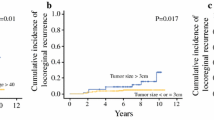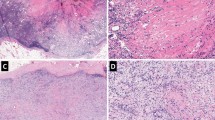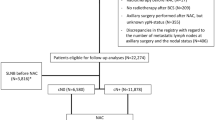Abstract
Background: Although preoperative chemotherapy has become the standard of care for inoperable locally advanced breast cancer, its role for downstaging resectable primary tumors is still evolving. The purpose of this study was to determine whether the prognostic information from an axillary node dissection in patients with clinical T3N0 breast cancer was altered by preoperative chemotherapy compared with surgery de novo.
Methods: Between 1976 and 1994, 91 patients with clinically node-negative operable T3 breast cancer received doxorubicin-based combination chemotherapy on protocol at one institution. Fifty-three patients received both preoperative and postoperative chemotherapy (PreopCT), and 38 received postoperative chemotherapy only (PostopCT). All patients underwent axillary lymph node dissection as part of their definitive surgical treatment. There were no differences between the PreopCT and PostopCT groups in median age (51 vs. 49 years), median tumor size at presentation (6 cm vs. 6 cm), tumor grade, or estrogen receptor status (estrogen receptor negative 38% vs. 32%). The median follow-up time was 7 years.
Results: Patients in the PreopCT group had fewer histologically positive lymph nodes (median, 0 vs. 3, P < .01), and a lower incidence of extranodal extension (19% vs. 42%, P 5 .02). By univariate analysis, the number of pathologically positive lymph nodes (P < .01) and extranodal extension (P < .01) were predictors of disease-specific survival in PreopCT patients. Multivariate analysis showed that extranodal extension was the only independent prognostic factor in PreopCT patients (P < .01). Overall, PreopCT and PostopCT patients had similar 5-year disease-free survival rates (66% vs. 57%); however, PreopCT patients had worse disease-free (P 5 .01) and diseasespecific survival (P 5 .04) when survival was compared after adjustment for the number of positive lymph nodes. Furthermore, PreopCT patients with 4–9 positive lymph nodes had a lower 5-year disease-free survival rate than PostopCT patients with 4–9 positive nodes (17 vs. 48%, P 5 .04).
Conclusions: Axillary lymph node status remains prognostic after chemotherapy. Pathologically positive lymph nodes after preoperative chemotherapy are associated with a worse prognosis than the same nodal status before chemotherapy.
Similar content being viewed by others
References
Singletary SE, McNeese MD, Hortobagyi GN. Feasibility of breast-conservation surgery after induction chemotherapy for locally advanced breast Cancer. Cancer 1992;69:2849–2852.
Schwartz GF, Birchansky CA, Komarnicky LT, et al. Induction chemotherapy followed by breast conservation for locally advanced carcinoma of the breast. Cancer 1994;73:362–369.
Kling KM, Ostrzega N, Schmit P. Breast conservation after induction chemotherapy for locally advanced breast cancer. Am Surg 1997;6:861–864.
Bonadonna G, Valagussa P, Brambilla C, et al. Primary chemotherapy in operable breast cancer: eight year experience at the Milan Cancer Institute. J Clin Oncol 1998;16:93–100.
Danforth DN, Zujewski J, O’Shaughnessy J, et al. Selection of local therapy after neoadjuvant chemotherapy in patients with stage III A,B breast cancer. Ann Surg Oncol 1998;5:150–158.
Fisher B, Bryant J, Wolmark N, et al. Effect of preoperative chemotherapy on the outcome of women with operable breast cancer. J Clin Oncol 1998;16:2672–2685.
McCready DR, Hortobagyi GN, Kau SW, et al. The prognostic significance of lymph node metastases after preoperative chemotherapy for locally advanced breast cancer. Arch Surg 1989;124: 21–25.
Botti C, Vici P, Lopez M, et al. Prognostic value of lymph node metastases after neoadjuvant chemotherapy for large-sized operable carcinoma of the breast. J Am Coll Surg 1995;181:202–208.
Kuerer HM, Newman LA, Buzdar AU, et al. Residual metastatic axillary lymph nodes following neoadjuvant chemotherapy predict disease-free survival in patients with locally advanced breast cancer. Am J Surg 1998;176:502–9.
Kaplan EL, Meier P. Nonparametric estimation from incomplete observations. J Am Stat Assoc 1958;185:1457–1481.
Cox DR. Regression models and life-tables. J R Stat Soc 1972;34:187–220.
Kuerer HM, Newman LA, Fornage BD, et al. Role of axillarylymph node dissection after tumor downstaging with induction chemotherapy for locally advanced breast cancer. Ann Surg Oncol 1998;5:673–680.
Schwartz GF, Cantor RI, Biermann WA. Neoadjuvant chemotherapy before definitive treatment for stage III carcinoma of the breast. Arch Surg 1987;122:1430–1434.
Kuerer HM, Sahin AA, Hunt KK, et al. Incidence and impact of documented eradication of breast cancer axillary lymph node metastases before surgery in patients treated with neoadjuvant chemotherapy. Ann Surg 1999;230:72–78.
Machiavelli MR, Romero AO, Perez JE, et al. Prognostic significance of pathological response of primary tumor and metastatic axillary lymph nodes after neoadjuvant chemotherapy for locally advanced breast carcinoma. Cancer J Sci Am 1998;4:125–131.
Miller KD, McCaskill-Stevens W, Sisk J, et al. Combination versus sequential doxorubicin and docetaxel as primary chemotherapy for breast cancer: a randomized pilot trial of the Hoosier Oncology Group. J Clin Oncol 1999;17:3033–3037.
Runnebaum IB, Nagarajan M, Bowman M, et al. Mutations in p53 as potential markers for human breast cancer. Proc Natl Acad Sc U S A 1991;88:10657–10661.
Harris AL, Nicholson S, Sainsbury R, et al. Epidermal growth factor receptor and other oncogenes as prognostic markers. J Natl Cancer Inst Monogr 1992;11:181–187.
Johnson MD, Torri JA, Lippman ME, et al. The role of cathepsin D in the invasiveness of human breast cancer cells. Cancer Res 1993;53:873–877.
Dhingra K, Hortobagyi GN. Critical evaluation of prognostic factors. Semin Oncol 1996;23:436–445.
Elledge RM, Allred DC. Prognostic and predictive value of p53 and p21 in breast cancer. Breast Cancer Res Treat 1998;52:79 –98.
Mimori K, Ueo H, Shirasaka C, et al. Up-regulated pyrimidine nucleoside phosphorylase in breast carcinoma correlates with lymph node metastasis. Ann Oncol 1999;10:111–113.
Yang X, Hao Y, Ding Z, et al. Differential expression of antiapoptotic gene BAG-1 in human breast normal and cancer cell lines and tissues. Clin Cancer Res 1999;5:1816 –1822.
Muss HB, Thor AD, Berry DA, et al. C-erbB-2 expression and response to adjuvant therapy in women with node-positive early breast cancer. N Engl J Med 1994;330:1260–1266.
Thor AD, Berry DA, Budman DR, et al. Erb-2, p53, and efficiency of adjuvant therapy in lymph node-positive breast cancer. J Nat Cancer Inst 1998;90:1346–1360.
Anderson BO, Jewell K, Eary JF, et al. Neoadjuvant chemotherapy contraindicates sentinel lymph node mapping in breast cancer. Proc Am Soc Clin Oncol 1999;18:71a.
Dookeran KA, Zaren HA. Sentinel lymph node biopsy in breast cancer patients treated with neoadjuvant chemotherapy. Proc Am Soc Clin Oncol 1999;18:72a.
Author information
Authors and Affiliations
Rights and permissions
About this article
Cite this article
Meric, F., Mirza, N.Q., Buzdar, A.U. et al. Prognostic Implications of Pathological Lymph Node Status After Preoperative Chemotherapy for Operable T3N0M0 Breast Cancer. Ann Surg Oncol 7, 435–440 (2000). https://doi.org/10.1007/s10434-000-0435-9
Received:
Accepted:
Issue Date:
DOI: https://doi.org/10.1007/s10434-000-0435-9




